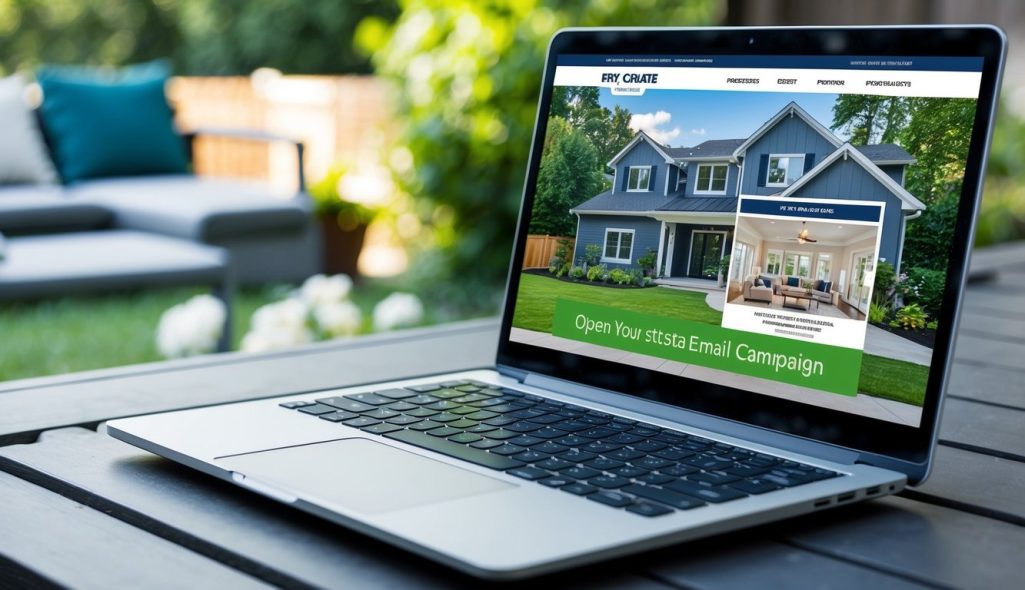Real estate email marketing is a powerful tool for building strong relationships with clients and boosting sales. By using targeted email campaigns, you can reach potential buyers and sellers effectively. This approach allows real estate agents to showcase their properties and share valuable industry insights.

In real estate, connecting with your audience is crucial. Using email marketing to engage with your audience can lead to higher engagement and more successful sales. By crafting personalized and relevant content, you can capture your clients’ attention and keep them coming back for more information. Whether you are informing your clients about market trends or new listings, email remains an essential communication channel.
To succeed in real estate email marketing, it’s important to build a solid strategy. By carefully growing your subscriber list and consistently delivering engaging content, you can maximize your return on investment. With the right approach, email marketing can become the backbone of your real estate business.
Key Takeaways
- Email marketing boosts client engagement and sales.
- Personalize content to attract and retain interest.
- Build strategy for maximizing ROI in real estate.
Understanding Real Estate Email Marketing
Real estate email marketing is a powerful tool for engaging prospects and enhancing your business. As a real estate agent, you can use email to build relationships and keep your clients informed.
The Importance of Email in Real Estate
Email remains a vital communication tool in real estate. It allows you to reach potential buyers and sellers directly. Unlike social media posts that may get lost in endless feeds, emails land in your client’s inbox. This direct line of communication helps you establish trust and maintain contact over time. You can update clients on new listings, market trends, and open house events. Effective email marketing fosters a personal connection, crucial in real estate transactions.
Benefits of Email Marketing for Realtors
Email marketing offers numerous benefits for realtors. Targeted campaigns mean you can send specific messages to different client segments. For instance, first-time buyers may need more guidance, while experienced investors seek market data. Cost efficiency is another advantage, making email campaigns affordable for realtors of all sizes. Another key benefit is trackability. You can measure open rates and click-through rates, providing data to refine your strategies. Using email allows you to boost client engagement and, ultimately, sales.
Email Marketing vs. Other Digital Marketing Strategies
When comparing email marketing to other digital strategies, its strengths become apparent. Email marketing gives you a direct connection with clients, unlike social media where organic reach is limited. While pay-per-click ads require ongoing budgets, emails are relatively low cost once your list is built. Additionally, an email is highly customizable, allowing you to personalize messages for individual clients, enhancing engagement. In essence, while other strategies are useful, email marketing remains an essential, cost-effective, and direct tool for building lasting client relationships.
Building Your Email Marketing Foundation
Establishing a solid foundation for your real estate email marketing involves selecting appropriate tools, crafting a strategy, and identifying your audience. These key steps will help you connect effectively with potential buyers and build lasting relationships through email campaigns.
Choosing the Right Email Marketing Platform
Selecting the right email marketing platform is crucial for your success. Look for platforms that are user-friendly and offer features like automation and customization. Popular options may include Mailchimp, Campaign Monitor, or Constant Contact.
It’s important to choose a platform with robust automation capabilities, allowing you to schedule and send emails without manual input. Also, ensure the platform supports creating segmented lists, which will help you tailor messages to different groups within your target audience.
Comparing different email marketing tools can help you find one that fits your budget and needs. Opt for a platform that integrates seamlessly with your existing marketing software to streamline your process.
Creating a Real Estate Email Marketing Strategy
A strong email marketing strategy is essential to engage your audience and drive results. Begin by setting clear goals, such as increasing open rates or generating leads. Develop a content calendar to plan when and what you will send.
Include various types of emails in your strategy, such as newsletters, welcome emails, and personalized content. Determine a frequency that keeps your audience interested without overwhelming them. Make use of A/B testing to refine your email content and improve performance.
Consider using a mix of text, images, and call-to-action (CTA) buttons to make your emails engaging. These elements help guide your audience toward taking action, like contacting you or visiting your website.
Understanding Your Target Audience
Knowing your target audience is vital for crafting messages that resonate. Start by identifying demographics such as age, location, and buying preferences of potential buyers. Use customer data and feedback from past email campaigns to refine your audience profiles.
Segment your email lists based on different characteristics, which allows for a more customized approach. This helps in delivering personalized content that speaks directly to the needs and interests of each group.
Continuous monitoring and analysis of audience behavior are crucial. Pay attention to metrics like open rates and click-through rates to understand what types of content are most effective and adjust your strategy accordingly.
Growing Your Subscriber List
Expanding your real estate email list is crucial for reaching more potential clients. Focus on effective lead generation techniques, using social media smartly, and offering exclusive content to incentivize sign-ups. These strategies will help you capture more email subscribers and enhance your marketing efforts.
Lead Generation Techniques
Lead generation is key to growing your email list. Start by using landing pages dedicated to sign-ups. These pages should be attractive and easy to navigate, clearly stating what subscribers get by signing up. Add opt-in forms on your website and blog that simply ask for name and email.
Engaging with potential clients at events like open houses or private showings is effective. Have a tablet ready to collect emails or use a sign-up sheet. Consider offering a simple giveaway or a chance to win a gift card. This can encourage people to share their contact information.
Networking is also important. When you meet potential clients, ask if they’d like to join your mailing list. Be ready to explain how your emails provide value, such as updates on neighborhood guides or real estate tips.
Using Social Media to Capture Emails
Social media is a powerful tool for capturing email addresses. Regularly share engaging content with clear calls-to-action that direct followers to your sign-up forms. Platforms like Facebook and Instagram allow you to create posts that link directly to your landing pages.
Run social media campaigns focused on collecting emails. Use paid ads targeting specific demographics interested in real estate. A well-crafted ad can drive more traffic to your email sign-up page.
Encourage sharing by posting content that resonates with your audience. Offer valuable information, such as real estate trends or special events, encouraging potential clients to sign up for more insights. Social media challenges or contests can increase engagement and draw more subscribers.
Incentivizing Sign-Ups with Exclusive Content
Offering exclusive content is a great way to boost sign-ups. Give new subscribers access to premium resources like neighborhood guides, market reports, or virtual tours of listings. Highlight these benefits prominently in your marketing materials.
Create valuable content that only subscribers can access, like in-depth real estate tips or early access to new listings. This makes your emails more appealing.
Webinars or online workshops can be offered as exclusive content. Topics like home buying tips or investment strategies are popular. Promote these events through your usual channels to get potential subscribers interested in signing up to access these opportunities.
Crafting Effective Email Content
Creating engaging emails involves making them visually attractive, intriguing at first glance, and personal. Good email content keeps your audience interested and encourages them to engage with your message.
Designing Engaging Email Templates
Your email templates should be visually appealing yet straightforward. Use a clean design with a clear structure so readers can easily find important information.
Images and Colors: Use high-quality images. Colors should match your real estate branding.
Call to Action (CTA): Include a prominent, easy-to-see CTA. For example, a button saying “View Listings Now” can encourage clicks.
Subtle customization options can make templates feel more personal. Remember, a simple and consistent design often works best for real estate email templates.
Writing Compelling Subject Lines
Subject lines are the first thing your readers see. Make them count. They should be short and capture attention quickly.
Keep it under 50 characters to make it mobile-friendly.
Use questions or intriguing statements to arouse curiosity. For example, “Want to Find Your Dream Home?”.
Personalization can increase open rates. Include the recipient’s name if possible. Avoid spammy language, as it might push your email to the junk folder.
The Art of Email Personalization
Personalization makes each recipient feel valued. Tailor your email copy by using recipient-specific details.
Segment your audience based on interests or previous interactions. This can involve sending listings that match their search history.
Make the email feel like a conversation rather than a broadcast. Simple greetings using the recipient’s name can have a big impact.
By offering relevant content, you engage your audience effectively. This approach shows respect for their preferences and keeps their attention on your communications, improving your marketing success.
Engagement and Follow-Up
Improving email marketing success in real estate involves understanding and enhancing both engagement and follow-up strategies. Key areas include measuring open and click-through rates, designing effective follow-up emails, and nurturing leads for better conversions.
Measuring Open Rates and Click-Through Rates
Open rates and click-through rates are vital metrics to track in any email campaign. Open rates indicate how many recipients have opened your email, offering insight into the effectiveness of your subject lines. To boost open rates, consider the time of day, sender name, and subject line clarity.
Click-through rates reveal how many recipients clicked on links within the email. These help gauge the relevance of your content and calls to action. Use A/B testing to experiment with different email elements to see what resonates best with your audience.
Use analytics tools to regularly review these metrics and adjust your strategies accordingly. By closely monitoring and tweaking these aspects, you can improve lead conversion rates and overall campaign performance.
Creating Effective Follow-Up Emails
When crafting follow-up emails, aim for brevity and clarity. Keeping emails between 50 and 125 words can increase response rates. Personalization is key—use the recipient’s name and tailor content to their specific needs or previous interactions.
Clearly state the action you want the recipient to take. For example, invite them to set a date for a property viewing. This approach makes it easy for potential clients to engage further with you.
Automated follow-up systems, like drip campaigns, can help streamline the process. By setting up automated flows, you ensure consistent communication with prospects, nurturing them over time without overwhelming them with too much information at once.
Strategies for Nurturing Leads
Lead nurturing involves building relationships with potential clients over time. Send tailored content that appeals to the recipient’s stage in the buying or selling process. Consider using real estate drip campaigns to deliver relevant information consistently.
Share market insights, property listings, and updates that demonstrate your expertise. By providing value without overt sales pitches, you can maintain interest and build trust. Digital tools and CRM integrations with platforms like Wise Agent can assist in managing these relationships effectively.
Engagement efforts should be refined based on recipient feedback and engagement patterns, helping maintain strong connections with potential clients and improving chances of conversion.
Advanced Email Marketing Techniques
Maximize your real estate marketing efforts by focusing on key strategies. This includes using email automation, refining your audience through segmentation, and boosting engagement with A/B testing.
Leveraging Email Automation
Email automation is essential for saving time and maintaining consistency. It involves setting up automated messages that send based on specific triggers, such as a new subscriber or a returned visitor. By establishing drip campaigns, you ensure consistent communication that nurtures leads over time.
Automation tools can help you schedule and personalize emails, increasing engagement. It’s crucial to craft messages that feel personal yet operate on autopilot. Always include useful information to engage readers and motivate action. This approach helps you manage your workload while increasing your efficiency and productivity.
Segmenting Your Email List
Segmenting your list means dividing subscribers into distinct groups based on certain criteria such as location, previous interactions, or buying behavior. By doing this, you can tailor your messages to meet specific needs, making them more relevant to each recipient.
For example, a first-time homebuyer might receive different content than a seasoned investor. You improve response rates and engagement when messages resonate with the audience’s interests. Implementing email segmentation strategies can lead to higher open rates and better client relationships by ensuring targeted and relevant communication.
A/B Testing for Better Results
A/B testing involves sending two versions of an email to a subset of your list to determine which performs better. This can be done with subject lines, images, call-to-action buttons, or email layouts.
Using A/B tests helps identify what captures your audience’s attention. By examining response rates, you refine your approach for optimal results. Consistently testing and refining your emails ensures you stay ahead of the curve, making informed decisions that enhance your overall campaign performance.
Keep an eye on metrics to see which elements drive the most engagement and adjust accordingly.
Real Estate Email Marketing Best Practices
Effective real estate email marketing involves several key strategies. You need to regularly update your email list to ensure relevance and engagement. Legal compliance is essential for building trust and avoiding penalties. Monitoring industry trends helps tailor your messages to current market conditions.
Regularly Updating Your Email List
Keeping your email list current is crucial. Regular updates and cleaning of your email list help maintain high engagement and conversion rates. Remove inactive subscribers periodically to improve deliverability. New contacts should be added frequently, especially after open houses or community events.
Segmenting your list based on preferences or previous interactions allows for personalized outreach. This way, you can send targeted emails that resonate with specific groups, increasing the likelihood of turning prospects into clients.
Ensuring Legal Compliance
Following legal guidelines is non-negotiable. CAN-SPAM compliance is critical for real estate email marketing. This involves providing a clear unsubscribe option in every email and honoring opt-out requests promptly. Make sure subject lines are not misleading and include your physical address.
Obtaining explicit consent from subscribers before sending marketing emails builds trust and ensures adherence to legal standards. This helps protect your reputation while minimizing the risk of fines or penalties from regulatory bodies.
Monitoring Industry Trends and Market Dynamics
Staying informed about housing market trends and email marketing for realtors can boost your campaigns. Understanding market dynamics allows you to craft messages that address current buyer and seller concerns. Use analytics tools to track performance and identify successful strategies.
Keeping an eye on real estate forecasts and changes in consumer behavior ensures your content remains relevant and engaging. This proactive approach helps you stay ahead, allowing you to adjust strategies as needed for better results.
Tracking and Improving Campaign Performance
To optimize real estate email marketing, focus on understanding analytics, gathering feedback, and adapting strategies. These elements help improve email open rates and conversion rates.
Analyzing Campaign Analytics
Using analytics tools, you can track key metrics like open rates and conversion rates. Real estate CRM systems often have built-in tools that show how your emails perform. By examining these, you can see what works well and what needs change.
Pay attention to metrics such as click-through rates and the time recipients spend on linked sites. These numbers give insight into how engaging your content is. Campaign monitoring helps you spot trends and identify potential improvements, allowing you to refine your strategies continuously.
Utilizing Feedback for Campaign Refinement
Feedback from your email recipients can be a treasure trove of information. Surveys and feedback forms included in your emails can reveal preferences and pain points. This data helps you decide which content resonates and which areas require improvement.
Use this feedback to tweak your messaging. Consider adjusting email frequency or changing subject lines if prompted by recipient input. Engaging audiences by acknowledging their feedback can boost your campaign’s effectiveness. Collecting feedback also shows your clients you care about their opinions, strengthening your relationship.
Continuous Learning and Adaptation
Successful email campaigns rely on constant adaptation. Stay informed about the latest email marketing strategies. Be open to trying new approaches, such as A/B testing subject lines or experimenting with different content styles.
Leverage the growing capabilities of real estate CRM systems to automate processes and gain fresh insights. Adjusting your approach based on analysis and feedback helps keep your campaigns relevant. This method increases your chances of improving both open rates and conversion across your audience segments.
Maximizing ROI and Conversions
To increase your success with real estate email marketing, focus on creating effective calls-to-action (CTAs), generating referrals through emails, and converting leads into clients. Each of these elements plays a critical role in boosting conversion rates and maximizing your return on investment.
Effective Calls-to-Action
Crafting a compelling call-to-action is vital for guiding email recipients toward desired outcomes. A strong CTA should be clear, concise, and action-oriented. Use verbs like “explore,” “discover,” or “schedule” to prompt action. Place your CTA prominently, ideally several times if the email is long, ensuring it stands out visually.
Personalize CTAs when possible to make potential customers feel valued. Segment your audience to tailor messages and CTAs that speak directly to specific needs or interests. This approach can significantly enhance conversion rates in your real estate marketing campaign. Ensuring your CTAs are mobile-friendly is also essential, given that many users check emails on their phones.
Generating Referrals through Email
Emails are a powerful tool for generating referrals. Encourage satisfied clients to share their positive experiences by offering incentives, such as discounts or gift cards. Highlight previous success stories in your emails as social proof to build trust and motivate action. Remind your current clients of the benefits of spreading the word about your services.
Create a referral program where customers can easily share your information with friends or family. Feature a simple link or button within your email as a quick way for recipients to recommend your services. This strategy helps generate leads from genuine, trusted sources. Always express gratitude to both the referrer and the new lead to reinforce positive relationships.
Converting Leads into Clients
Once you have a potential lead, the goal shifts to converting them into a client. Consistent follow-up is key; send timely emails that engage and inform. Use data and analytics to understand recipient behavior and preferences, adjusting your approach accordingly.
Tailor your content to address specific concerns or questions they may have about buying or selling a house. Including testimonials and case studies can also reassure leads of your expertise and success rate. Demonstrating your knowledge and providing valuable insights can establish trust.
Ensure your email marketing strategy includes personalized communication, which strengthens the connection and boosts the likelihood of a successful conversion.
Real Estate Specific Campaigns
Creating effective email marketing campaigns in real estate involves crafting messages suited to different aspects of the property industry. You should focus on engaging your audience with useful content and clear calls to action. Each type of campaign can help real estate agents and realtors address specific needs and interests.
Listing Announcements
Listing announcements are critical for attracting potential home buyers to new properties. When crafting these emails, highlight key features, including the price, location, and unique selling points of the listings. Include high-quality images and virtual tour links for added appeal. A call to action encouraging recipients to schedule a viewing or contact you for more information helps engage both cold leads and warm leads. Regular updates on new listings keep your audience informed and engaged.
Neighborhood Spotlights
Neighborhood spotlights help showcase the benefits of specific areas to potential buyers and renters. You can introduce local amenities such as schools, parks, and shopping centers. Highlighting community events and historical landmarks adds personal touches that resonate with prospects.
Realtors can use these emails to position themselves as knowledgeable guides. They can also be a tool for staying connected with former clients who might be interested in another move or investment.
Home Buying and Selling Guides
Providing valuable information through home buying and selling guides can build trust with your audience. These guides might include tips on preparing a home for sale, financing options for buyers, or the steps in the home buying process.
Creating a series of emails that cover different stages of buying or selling keeps your audience engaged over time. This strategy targets both new and repeat clients, offering them helpful advice and positioning you as an expert in real estate.
Frequently Asked Questions
Real estate email marketing involves using strategic approaches to engage your audience effectively and selecting the right platforms for distribution. Crafting engaging content and understanding list segmentation is crucial for success.
What are effective real estate email marketing strategies?
Utilize a well-built email list and target segments based on interest, like first-time buyers or luxury home seekers. Tailor your messages for each segment to increase relevance and engagement. Consistency in sending emails can help maintain a connection with your audience.
How can I create compelling email content for real estate marketing?
Focus on clear, engaging subject lines and visuals. Include valuable information, such as market trends or property listings, to capture interest. Personalize content by addressing recipients by name and using specific details relevant to their property needs or interests.
Which email marketing platforms are most beneficial for real estate professionals?
Platforms such as Mailchimp, Constant Contact, and ActiveCampaign are tailored for real estate needs. They offer features like automation, analytics, and templates designed to enhance your email marketing efforts.
What should be included in a real estate marketing email to maximize engagement?
Your email should feature compelling visuals, a strong call-to-action, and concise, informative content. Provide links to property listings or virtual tours and ensure your contact information is easily accessible. Testimonials or success stories can also boost engagement.
How do real estate investors successfully utilize email marketing?
Investors often send market analysis and investment opportunities via email. They segment lists to tailor content and ensure it matches the investment level or interest of their audience. Including case studies of successful investments can also attract potential investors.
What are the best practices for segmenting an email list in real estate marketing?
Segment your list based on criteria like buying history, geographical location, or demographics. This allows you to customize content to meet specific audience needs.
Regularly update and clean your list to remove inactive addresses and optimize engagement rates.





